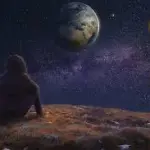 Cultures can be defined by their stories. Today, some of our most powerful stories are conveyed through the medium of film. In 1982, a film that would go on to become a cult classic was released, and it had a profound intellectual and spiritual impact on me. That film was “Blade Runner,” starring Harrison Ford, Rutger Hauer, Sean Young, Daryl Hannah, and Joe Tarkel.
Cultures can be defined by their stories. Today, some of our most powerful stories are conveyed through the medium of film. In 1982, a film that would go on to become a cult classic was released, and it had a profound intellectual and spiritual impact on me. That film was “Blade Runner,” starring Harrison Ford, Rutger Hauer, Sean Young, Daryl Hannah, and Joe Tarkel.
I was an impressionable young middle schooler back then, and I admit that at the time most of the subtleties and nuances of the film were lost on me. It was the mood of the film and the powerful soundtrack by Vangelis that initially captured my attention. Today, having seen the film dozens of times (many different cuts of it), its impact on me has only intensified, and when asked what my favorite film is, I don’t even hesitate: it’s “Blade Runner” (and its sequel, “Blade Runner 2049,” which I will be discussing in a future article). I hope to do the film justice here, in part one of what will be two installments, as I attempt to convey the film’s influence on me, and perhaps I might even inspire the readers to view the film and draw their own conclusions as to its quality and relevance as an impactful story.
Before I can discuss the film’s finer points, a brief overview of its basic plotline is in order to establish a context (spoilers for the film are on the way). The year is 2019 (I know that’s actually true, but that is when the film is set—many years into the future from the film’s release year). Mankind has reached out to the stars, establishing off-world colonies (we’re a little behind on getting this done), which are an enticing draw for humans looking for a fresh start away from an environmentally damaged Earth. Space is a dangerous place, and to take on the challenges of colonization considered too hazardous for humans to tackle, the Replicants step in. They are genetically engineered/enhanced super-humans, specifically designed by the Tyrell Corporation to serve as soldiers, laborers…even prostitutes. However, the Replicants are illegal on Earth, and that’s where the Blade Runners take the stage. Harrison Ford portrays Rick Deckard, a recently retired Blade Runner, or special police officer tasked with Replicant “retirement,” or elimination, should a Replicant be discovered on Earth. Deckard is convinced to come out of retirement by his former boss in an attempt to “retire” four renegade Replicants who have returned to Earth, an unusual occurrence.
We soon learn why the Replicants have returned. All Replicants are designed with a four-year life span to prevent them from living long enough to develop empathy (which would make them difficult to detect) or other powerful emotions, or to organize some manner of organized resistance against the humans who control the colonies, and Earth. The Replicants have returned to seek out Eldon Tyrell, founder of the Tyrell Corporation, so that he might somehow extend their limited life spans.
In the early stages of his investigation, Deckard visits the Tyrell Corporation, where he is introduced to Rachel, a Replicant herself who works for Tyrell. Rachel is new model, a Nexus-6, who is unaware she is actually a Replicant. A relationship develops between the two as Rachel explores her own identity and searches for meaning (Rachel’s situation will be explored in the next installment).
The Replicants soon learn that Tyrell is unable to help them, and their leader, Roy Batty, kills him in frustration. Deckard systematically hunts the Replicants down until only he and Batty remain, setting up a climactic battle between the two on a rain-drenched rooftop. In the end, Deckard is victorious only through the mercy of Batty, who saves Deckard from a deadly fall off of the building. Why does Batty do this? We’ll discuss that momentarily. The final scene of the film has Deckard and Rachel escaping together into the night (depending on which cut of the film you see, this being how the Director’s Cut ends).
So, what makes this film such a special one? Is it not just a dark, futuristic, and ultimately forgettable detective story? Oh no. There is a lot more going on here. Let’s break some of that down.
One of the first resonant messages I took away from the film was expressed in the Tyrell Corporation’s motto: “More human than human.” The Replicants were designed with enhanced capabilities—greater strength, greater speed, heightened senses—characteristics that would enable them to survive the harsh conditions of the off-world colonies. In that sense they indeed lived up to the motto; they had more of the qualities that naturally born humans possessed. Paradoxically, their status as Replicants also made them less than human, as they were treated as a slave caste, designed for a specific purpose or destiny from which there was no escape save death. They were not permitted to seek their own destinies, and did not have the time to build them due to their limited life spans. What did their enhanced abilities really give them when the avenues for using those abilities were not theirs to choose? They could choose to exist in the narrow niche for which they were designed, or to rebel and face “retirement” at the hands of the Blade Runners. What would you do?
One of the film’s most powerful scenes comes near the end during the climactic battle between Rick Deckard and Roy Batty. As Batty was designed as a “combat” model Replicant, Deckard’s skills are no match for him. Batty is slowly “dying,” having reached the limits of his lifespan, but he seems determined to exact vengeance on Deckard for “retiring” his fellow renegade Replicants earlier in the film. Beaten and exhausted, Deckard attempts to leap from one rooftop to the adjacent one to escape from Batty, only to fall short and end up hanging from the edge of the far building’s roof, clinging to it with a hand that has two broken fingers. Batty makes the same leap effortlessly, and stands over Deckard, grinning as the Blade Runner holds on for his life. “Quite an experience to live in fear, isn’t it? That’s what it is to be a slave,” Batty says. He lets Deckard hang there, giving him the chance to truly feel what facing imminent death is really like.
Unable to hold on any longer, Deckard loses his grip, but before he can fall Batty grabs him by the wrist, lifts him up, and unceremoniously dumps him back on the rooftop. The Replicant then sits down beside his astonished and bone-weary opponent, and says: “I’ve seen things you people wouldn’t believe… Attack ships on fire off the shoulder of Orion. I watched C-beams glitter in the dark near the Tannhäuser Gate. All those moments will be lost in time, like tears in rain. Time to die.” It is a sad and profound scene. Here was an artificially created being, contemplating the memories of his brief life, musing on how those memories will disappear forever once he is gone, and at last accepting his fate.
The viewer empathizes with Batty here, despite the ruthlessness and cruelty he has displayed during the film up to this point. In this last minute of his existence, he demonstrates the truth of the Tyrell Corporation’s motto; he ends his life in acceptance of his destiny, actually grieving that the images and emotions of his memories will die with him. He isn’t human, but don’t tell him he isn’t alive, or that his life wasn’t worth living. He also saves Deckard–the human, the Blade Runner, the killer of his companions—realizing in the end that life is too precious a thing to allow even an enemy bent on destroying him to die if he can prevent it. Would a human have done as much for him—the “machine,” or slave?
For me, this “tears in rain” moment always causes me to stop and reflect on just how delicate and brief our lives are. Each of us is only a phone call, a doctor’s visit, or one “wrong place at the wrong time” moment away from facing the prospect of our imminent death. However, until that moment actually arrives, we have a tendency to take our lives for granted, being bothered by what, in the big picture, are actually inconsequential things and believing that death is only something that happens to “other people.” When we face death, we realize how trivial our daily concerns really are.
A practice we would all do well to adopt is the “negative visualization” strategy from the Stoic tradition. Imagine, for a brief interlude each day, that you have lost that which is most precious to you, or that you are facing the end of your life. Really feel the emotions associated with that situation, just for a few minutes. Visualize what life would be like were that potentiality to come to pass. Then, when you return to the present moment and your actual circumstances, let yourself feel the gratitude that you still have what you just moments before had imagined losing, and stop taking him/her/it for granted. This way, when great loss does eventually come, you will feel less regret, knowing that you made the most of what you had while you had it.
Roy Batty, shackled with a four year total life span, valued his life enough to risk it in an attempt to prolong it, and failing that, saved the life of one who would have taken his life away from him if given the opportunity. As the Replicants have such short lives, they value them more consistently and work to make the most of them, whatever their predetermined destinies might be. In this case, the creator can learn from the creation.
In Part Two, coming in December, we will more closely examine Rachel, the Nexus-6 Replicant, who is unaware of her Replicant nature, and is a prototype with “no termination date.” Rachel’s quest for answers mirrors our own in many ways as we all search for what it is to be truly human. Until then, if you have the opportunity to watch “Blade Runner,” I would be interested to know what you think (it would make a great Halloween party movie too!).












